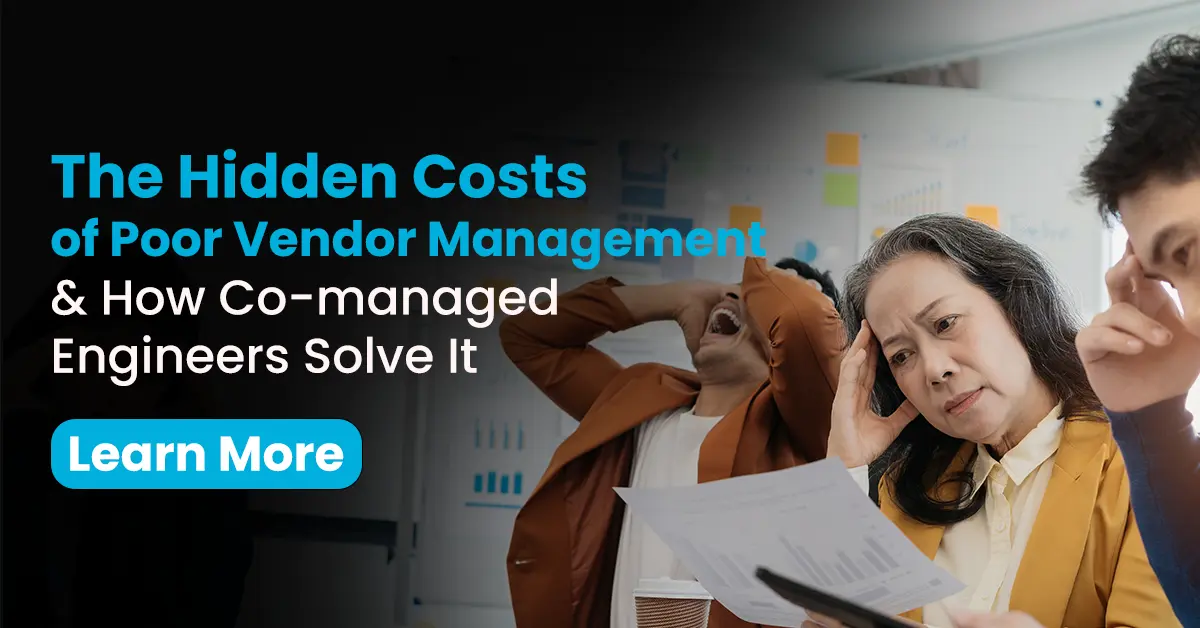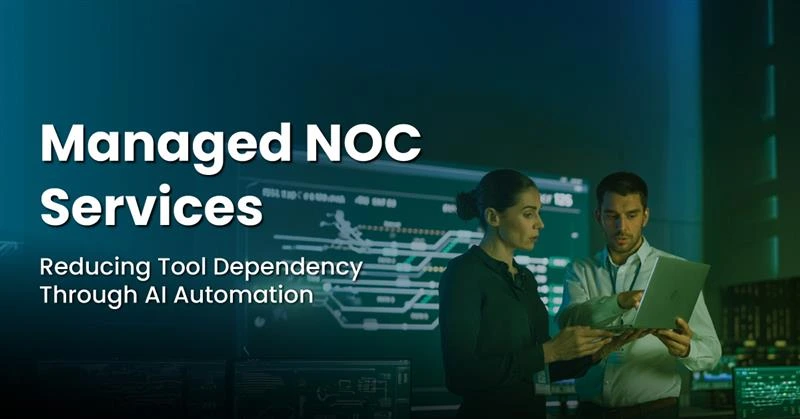Businesses, nowadays, are increasingly reliant on external tech vendors to fill skill gaps and manage specialized systems. According to a survey from Deloitte, nearly 45.13% of businesses opt for offshore IT outsourcing, which involves third-party vendors. Further, 81% of executives use third-party vendors for cybersecurity, and 75% leverage data and analytics through external providers. IT outsourcing is used by nearly 9 out of every 10 global companies.
Despite that, few organizations truly understand what poor vendor management is costing them. Behind the obvious invoice amounts lies a labyrinth of hidden expenses that silently drain resources and hamper growth. This is where co-managed engineers have emerged as a game-changing solution, bridging the gap between fully outsourced services and in-house expertise.
The Escalating Price Tag of Ineffective Vendor Management
Before we dive into solutions, let’s talk about the problem. According to a recent industry report by Deloitte, companies lose an average of 20-30% of value in vendor relationships due to ineffective management practices. That’s not just pennies—it’s serious money vanishing from your bottom line.
Co-managed engineers represent a fundamental shift in how businesses approach technical expertise acquisition. Unlike traditional vendor relationships where communication bottlenecks and misaligned priorities are common, co-managed engineers become an integrated part of your team while bringing specialized expertise.
Quantifying Direct Financial Losses
The most obvious costs of poor vendor management show up as budget overruns. When vendors underbid to win contracts or scope creep occurs without proper controls, what seemed like a cost-effective solution quickly becomes a financial drain. Emergency troubleshooting fees—those painful “after hours” rates—can quickly double or triple expected costs.
Consider this: businesses employing co-managed dedicated engineers report up to 40% reduction in emergency service calls, as these professionals proactively address potential issues before they escalate into costly emergencies. Co-managed network engineers can identify network vulnerabilities before they trigger expensive downtime events.
The Invisible Drain on Resources
The less obvious costs might be even more damaging to your organization:
- Management overhead: On average, an IT director spends 15+ hours weekly managing vendor relationships instead of focusing on strategic initiatives.
- Knowledge fragmentation: When co-managed remote engineers aren’t part of the equation, critical institutional knowledge gets siloed among different vendors, creating expensive dependencies.
- Productivity losses: Systems that don’t work seamlessly together due to multiple vendor implementations cause daily friction for employees.
Co-managed engineers eliminate these inefficiencies by providing continuity of service and knowledge. By working alongside your internal team, co-managed dedicated engineers develop deep familiarity with your business context while bringing specialized expertise that would be prohibitively expensive to maintain in-house.
Strategic Business Impact
Perhaps most concerning are the strategic opportunities lost when vendor management consumes too many resources:
- Delayed project timelines affecting competitive market positioning
- Inconsistent service quality damaging customer trust
- Security vulnerabilities from inadequate vendor oversight
These strategic impacts represent the true cost of poor vendor management—not just dollars spent, but opportunities missed, and risks incurred.
The Co-Managed Engineer Approach: A Strategic Solution
The rise of co-managed engineers represents a hybrid approach that addresses the fundamental limitations of traditional vendor relationships. By combining the best elements of in-house and outsourced resources, businesses gain substantial advantages.
MSP staffing has evolved significantly from simple “body shop” approaches to strategic talent solutions. Today’s co-managed engineers don’t just fill seats—they fill critical capability gaps while maintaining continuity with your organization.
What Are Co-Managed Engineers and How They Differ
Co-managed engineers represent a fundamentally different approach to technical expertise. Unlike conventional contractors who operate at arm’s length, co-managed dedicated engineers function as extensions of your internal team while being employed by specialized MSP staffing companies.
This arrangement creates unique advantages:
- Shared accountability: Co-managed network engineers have skin in the game regarding your outcomes.
- Knowledge retention: Co-managed remote engineers build institutional memory that stays with your organization.
- Flexible scaling: Resources can expand or be contract-based depending on project needs without sacrificing continuity.
When implementing co-managed engineers through reliable staffing MSP providers, organizations gain access to specialized talent pools that would be challenging to recruit and retain internally.
Core Benefits of the Co-Managed Model
The co-managed engineering model shines in several key areas:
- Continuity of service: Unlike rotating vendor personnel, co-managed engineers maintain consistent presence and knowledge of your environment.
- Skill augmentation: Internal teams are strengthened by specialized knowledge from co-managed dedicated engineers.
- Cost predictability: Fixed monthly rates from MSP staffing companies eliminate budget surprises.
- Reduced management overhead: Fewer vendor relationships mean less administrative burden.
Co-managed network engineers have proven particularly valuable in maintaining complex networking environments while reducing the coordination challenges of multiple specialized vendors.
How Co-Managed Remote Engineers Transform Vendor Management
The transformative impact of bringing co-managed engineers into your technical operations extends across multiple dimensions of vendor management.
When organizations implement co-managed engineers, they fundamentally change their approach to technical resources. This shift creates ripple effects throughout the business.
Streamlining Communication Channels
The complexity of managing multiple vendor relationships creates substantial overhead:
- Multiple portals and ticketing systems
- Inconsistent reporting mechanisms
- Conflicting priorities and escalation paths
Co-managed dedicated engineers dramatically simplify this landscape by providing a single, consistent interface between your business needs and technical implementation. Co-managed remote engineers utilize your internal communication tools and adapt to your processes, eliminating the friction of multiple vendor protocols.
Eliminating Cost Inefficiencies
The financial advantages of co-managed engineers extend beyond the obvious:
- Predictable budgeting: Fixed monthly costs from staffing MSP providers vs. variable vendor billing
- Reduced redundancy: Elimination of overlapping services across multiple vendors
- Prevention of scope creep: Co-managed network engineers understand your environment holistically
- Lower training costs: Reduced onboarding and knowledge transfer expenses
Enhancing Operational Quality
Perhaps most importantly, co-managed engineers deliver superior operational outcomes:
- Technical decisions informed by business context awareness
- Consistent service delivery vs. vendor variability
- Customized solutions instead of one-size-fits-all approaches
- Proactive problem-solving vs. reactive vendor support
Co-managed remote engineers combine the benefits of internal staff’s business knowledge with external expertise, creating a powerful synergy that traditional vendor relationships simply can’t match.
Implementing a Co-Managed Engineering Strategy with MSP Staffing
Successfully implementing co-managed engineers requires thoughtful planning and selection of the right partner. The transition from traditional vendor management to a co-managed approach delivers substantial benefits but requires careful execution.
Assessing Your Vendor Management Pain Points
Begin by honestly evaluating your current vendor landscape:
- How many hours does your team spend managing vendor relationships?
- Where do knowledge gaps create dependencies or inefficiencies?
- Which technical areas would benefit most from dedicated expertise?
This assessment creates the foundation for effectively implementing co-managed engineers in the areas of greatest need and potential impact.
Selecting the Right Staffing for Managed Services Partner
Not all staffing MSP providers are created equal. When evaluating potential partners for co-managed engineers, consider:
- Industry-specific expertise and experience
- Bench strength and resource continuity guarantees
- Communication protocols and escalation processes
- Cultural alignment with your organization
The right partner for providing co-managed dedicated engineers should demonstrate strong technical capabilities while understanding your business context and priorities.
Transition Planning and Implementation Roadmap
A successful transition to co-managed engineers typically follows a phased approach:
- Assessment and planning
- Initial knowledge transfer
- Parallel operations period
- Complete transition and optimization
Throughout this process, co-managed network engineers work alongside existing resources to ensure continuity while gradually assuming greater responsibility.
Future-Proofing Your Business with Co-Managed Engineering Teams
The co-managed engineer model isn’t just about solving today’s vendor management challenges—it’s about creating a flexible, adaptive technical foundation for your business.
As technology continues to evolve at an accelerating pace, the traditional approach of hiring specialized vendors for each new technology becomes increasingly unsustainable. Co-managed engineers provide a more flexible, adaptive approach.
Building Adaptability into Your Technical Operations
Co-managed engineers create technical resilience through:
- Continuous knowledge transfer between external experts and internal teams
- Balanced resource allocation across maintenance and innovation
- Scalable capacity without proportional cost increases
- Sustainable knowledge management systems
This adaptability translates directly to competitive advantage in rapidly changing markets where technical agility determines winners and losers.
Conclusion
The hidden costs of ineffective vendor management silently drain resources from your organization every day. From fragmented knowledge to management overhead, these expenses go far beyond what appears on vendor invoices.
IT By Design’s co-managed engineers offer a proven solution that blends the reliability of internal teams with specialized expertise from dedicated professionals. Our co-managed dedicated engineers, co-managed network engineers, and co-managed remote engineers seamlessly integrate with your team while eliminating the friction of traditional vendor relationships.
Ready to stop the hidden drain on your resources? Schedule a meeting with us today to discover how our co-managed engineers can transform your technical operations while significantly reducing costs. Your future competitive advantage starts with the right technical partnership – let’s build it together.








